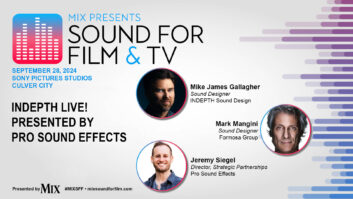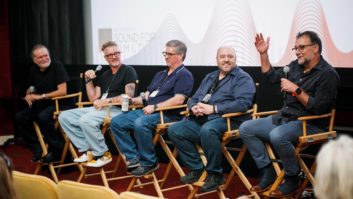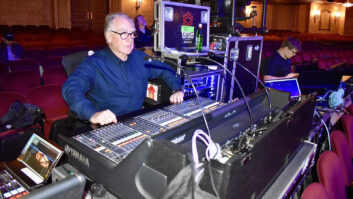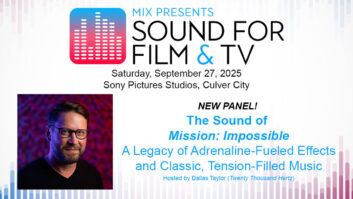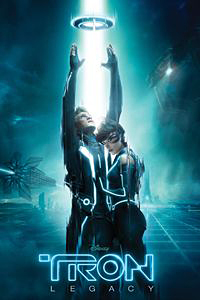
The hit film Tron: Legacy features a unique blend of electronic and symphonic score elements from the French techno duo Daft Punk (Guy-Manuel de Homem-Christo and Thomas Bangalter) and futuristic sound effects. We asked supervising sound editor/sound designer Addison Teague (Avatar, Pirates of the Caribbean: At World’s End) a few questions about this interesting marriage.
My understanding is that from the outset, the Daft Punk music was always going to be very prominent in Tron: Legacy.
My first screening of the movie was in February 2010 with [director] Joe Kozinski and Daft Punk. When the lights came up and they began to speak, I realized they were already in music-tweak mode on the score. I’m telling you this so you understand that it wasn’t just that Daft Punk was going to be prominent in the film, but they wrote the music that far in advance. Other than some subtle revisions and orchestrations and recording to finish the score, every piece of score was in place long before the sound effects team went to work.
So how did that affect the overall sound design?
Having Daft Punk’s score essentially completed before we started our work was a major factor in defining sound effects. The Recognizer [a fantastical hovering vehicle] is a perfect example. Visually this vehicle was an update from the original version, and we wanted to do the same with the sound effects.
The original Recognizer had a unique pulsing effect as it flew through the air. We started with rocket elements, to ground the VFX, and then created new pulse elements. The main challenge was not coming up with an interesting pulse, but making one that could co-exist with the music. The music through this sequence happened to already be driven with pulsing bass lines, so everything we tried to lay against it just ruined the clarity of the music. The solution was to add sounds that enhanced what the music was already doing, adding perspective to shots and sounds that made you believe Sam is flying through a city in a vehicle you’ve never seen before. This is a place where music and FX blurred together in a way that just works.
There are times in this movie when it may not be clear if music or FX are responsible for what you are hearing. When they work together, it doesn’t matter, because it is working, period. All that matters is the sound is enhancing the escape for the audience.
Were some of the SFX elements inspired by or affected by the music, or vice-versa?
Daft Punk brought a signature sound to the film before a single sound effect was added, so it was our job to take it even further. The music was so unique and bold, it needed to be embraced, and so the approach was figuring out how to work within the remaining frequencies and deliver sounds that made the world come to life, and felt true to what you were seeing on screen. The “discs” [a type of light weapon] are a great example of where this worked. Higher frequencies were needed to create the lethal hi-tech spinning blade, while Daft Punk kept the energy driving with their unique percussion and bass lines. In the first moment you see a disc power up, music took a back seat and gave us room to give it a low frequency element that made if feel more powerful and full of energy. The fast flying discs also called for pitch bending, which is one of the more successful techniques when trying to make sounds cut through music, because the brain latches onto a sound that is changing, and singles it out.
When it came time for the final mix, was the balancing of the music and FX any different or more challenging than a film with a more “conventional” score?
We were at an advantage to have had the music to work against while editing, because sound effect concepts that just would never work with the music could be abandoned and redesigned. Sound effect playbacks for Joe were a two-part critique. First, the bare sound effect, and if he liked it, then came the real test: “Now let me hear it with the music.” I never auditioned any sounds to Joe without having the music for the specific scene on a fader. This created more do-overs than working in isolation from music, but we never have the score on movies, and knowing what a player this one was going to be, it was the only way to proceed.
This could only take us so far though, and [re-recording mixers] Chris Boyes and Gary Rizzo were more challenged at finding the SFX/music balance than just about any film they’d mixed. Many times on other films we have to drop a sound effect if it happens to blur the first notes of a new musical phrase. Daft Punk’s music, which is comprised of many evolving loops, freed us from that problem but created a new obstacle for the mixers, and that was maintaining the intense building energy of Daft Punk’s music. The further we were into a scene, the harder it was to make an effect read, because the smallest adjustment in certain music elements that might typically give room for a sound effect, in Daft Punk’s score felt like the energy of a scene dropped off. So Chris and Gary constantly worked to maintain the overall build, all while dodging and weaving sound effects and trying to keep the overall mix at reasonable levels.
On the FX side, so often we hear about designers wanting FX to be “organic” and made up of natural elements. Was this an opportunity to really head in the other direction—more electronic sources, more surreal, more futuristic?
That’s what we thought going into the job, but Joe’s initial direction was to first ground the VFX with organic sounds, and only when that was achieved would we begin to explore supplemental electronic design.
More than any other movie I’ve worked on, it was appropriate to deconstruct and manipulate sounds in digital extremes. You can get away with more of that when your movie takes place inside a computer. It was fun to experiment and come up with sounds that you’ve never heard before. You aren’t going to be able to use them on a western but for Tron, go for it!
To bring this challenge full circle, these are the types of sounds that Daft Punk are famous for making, so the style of the sound effects for Tron began to blur with the style of the music for Tron, adding to the challenge of a final track where both could co-exist.
Blair Jackson is Mix’s senior editor.
For more information about the sound for Tron: Legacy, watch the SoundWorks Collection video ‘Tron Legacy’ Sound for Film Profile, in which we talk with sound re-recording mixer Gary Rizzo, supervising sound editor Gwen Yates Whittle and sound designer Steve Boeddeker.


